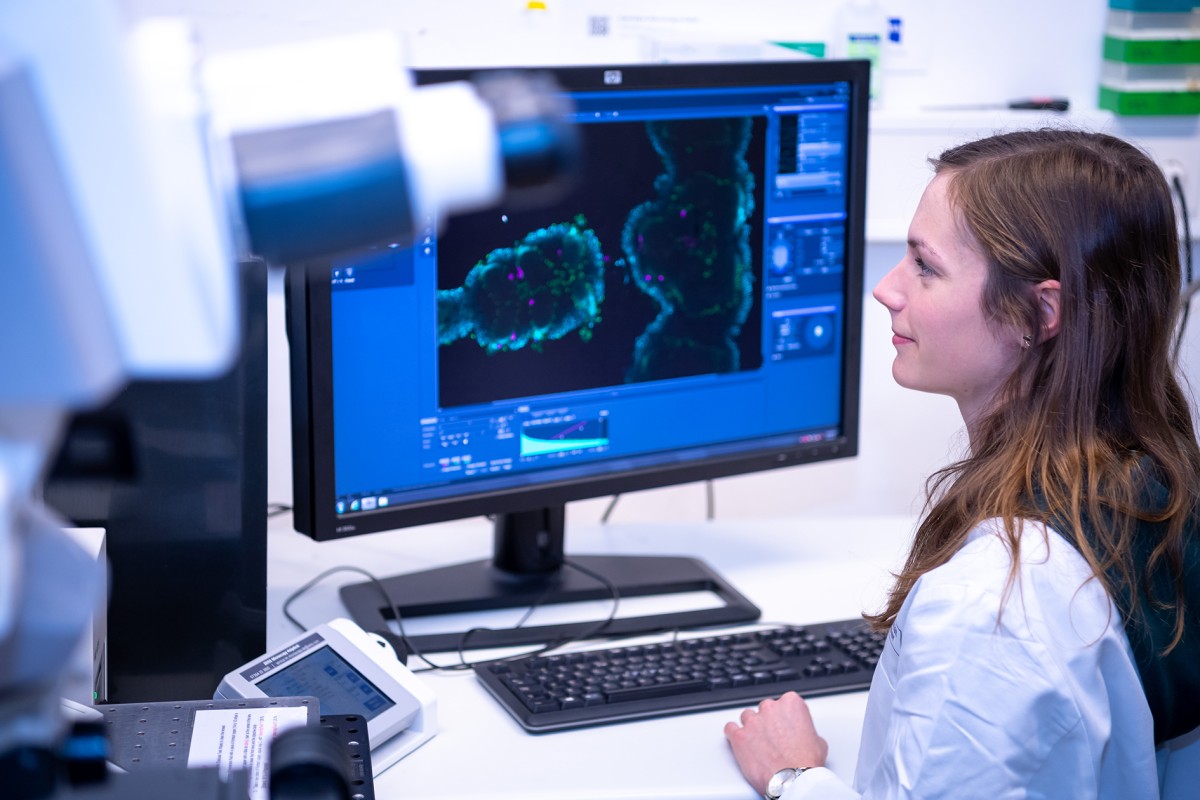
“The balance is extremely important”
When you enter the Institute of Neuro- and Behavioural Biology at Badestraße 9 and go up the stairs on the left … what you immediately see are the rows of pictures in the stairwell and the corridors. They look fascinating, in bright vibrant colours – but what they actually show is not apparent to the non-specialist at first glance. In fact, they are microscopic views of the insides of fruit flies.
The stairs lead to the first floor, to the working group headed by Prof. Christian Klämbt, who, with his team, has been studying fruit flies (Drosophila melanogaster) for some years now. The researchers here are interested in which molecular processes control the development of the brain, and how the interaction between the various cells in the brain controls the insects’ behaviour.
PhD student Bente Winkler, 30, is looking in particular at inflammatory processes in the brains of the small insects. “Fruit flies are ideally suited for research into basic mechanisms,” she says. “The structure of their brains is simpler than in mice, and it’s relatively easy under the microscope to observe what happens in the living fly’s brain.” Also, a lot of research has already been carried out on fruit flies, and in this model organism genetic modifications can be carried out relatively easily to obtain indications of the function of the genes. Christian Klämbt’s team get the genetically modified Drosophila strains from research colleagues – or they produce the desired modifications themselves, using modern molecular-genetic methods.
In one of the labs, Bente Winkler points to several hundred small plastic tubes, each with an air-permeable stopper made of a foam material. They are stored in climate-controlled cabinets, on numerous shelves and in boxes. Upon closer inspection, adult fruit flies can be seen moving in some of the tubes, while in others there are eggs or pupae. When the tiny insects are transferred to clean tubes with fresh food, delicate fingers are required – as is a stereomicroscope for recognising the fruit flies, which can be distinguished from one another by means of various features. “We do the breeding ourselves,” says biologist Winkler. “To this end, we spend hours of hard work at the microscope selecting suitable flies.” Special skill is needed in preparing the fruit flies for fluorescence microscopy. For this purpose, Winkler has to prepare the animals in such a way that it is then possible to take a look inside the brain.
"For the first time, an opportunity is presenting itself for using Drosophila as a model organism for studying this complex immune response."
The inflammatory processes in a fruit fly’s brain which interest her occur in a similar form in humans. Normally the brain in humans and other vertebrates, as well as insects, is protected by the blood-brain barrier, and immune cells cannot get into the brain. However, infections or diseases such as multiple sclerosis can give rise to inflammations in the brain. In consequence, immune cells – including macrophages – can get past the blood-brain barrier and combat any bacteria and viruses which have invaded the brain. But this immune response can – if not properly controlled – cause damage to the brain because the macrophages can also attack the healthy nerve cells. “This means that the balance of the immune response is extremely important,” says Winkler.
In the case of a bacterial infection of the brain in insects, such an invasion of macrophages occurs across the blood-brain barrier, and this is a new insight: Bente Winkler recently found evidence of this in fruit fly pupae in collaboration not only with other researchers in the Klämbt team but also with research institutes in France and the USA.
“We identified molecular signals which allow the macrophages to penetrate into the brain,” Winkler says. After an infection of the brain, a so-called NF-kappaB transcription factor has to be activated in glial cells. This results in a signalling protein being formed which controls such a penetration by the macrophages. Glial cells not only play an important role in organising the immune response in the brain – they are also involved in the interconnection of nerve cells during the early stages of the brain’s development. They are also necessary for signal transduction between the nerve cells.
“Bente Winkler’s discovery is significant, also with a view to medical issues,” her PhD supervisor Christian Klämbt emphasises. “For the first time, an opportunity is presenting itself for using Drosophila as a model organism for studying this complex immune response. If we can succeed in gaining a better understanding of how macrophages get past the blood-brain barrier, and how their activity is regulated, this can help in the development of new strategies for treating sick people.”
Down through the stairwell, past the colourful pictures, the way back leads to the ground floor. Here there are more laboratory rooms with ultra-modern laser scanning microscopes, which are indispensable for gaining insights into the nervous system of living fruit flies. With the aid of these microscopes, Bente Winkler would now like to embark on further studies to try and decipher the molecular signalling cascade which attracts the macrophages. As an offshoot, maybe that will produce more spectacular images of the fruit fly’s brain which could take their place in the gallery in the corridor.
Authors: Christina Hoppenbrock & Kathrin Kottke
This article first appeared in the University newspaper "wissen|leben”, No. 8. 15 December 2021.
Original publication:
Bente Winkler et al. (2021): Brain inflammation triggers macrophage invasion across the blood-brain barrier in Drosophila during pupal stages. Science Advances Vol 7, Issue 44; DOI: 10.1126/sciadv.abh0050




